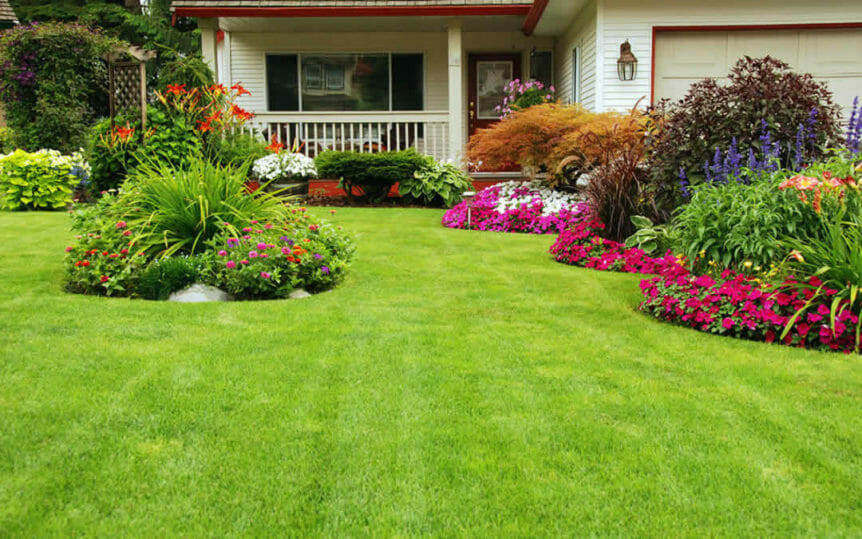
Keep Your Yard Bright With Winter Lawn Treatment
Hey Houston, it’s finally starting to get a little chilly out there! It isn’t quite the dead of winter yet, but it’s definitely time to start thinking about the other beings you need to keep warm this winter, and no, it’s not your kids! We’re talking about your lawn, shrubs, and flowers, which are all living things that need your love and attention. Our friends up north might think we’re crazy for piling on a million layers in 50-degree weather, but we Texans know our limits. And plants have limits, too. They don’t adapt very well when they are exposed to very cold weather (sounds like us, right?). We recommend you treat your plants the way you would want to be treated, and that means giving them enough water to drink, good soil to grow in and get nutrients from, lots of sun, and of course, protecting them from nature’s wrath.
There are a few things to consider in Houston when prepping your lawn before and during the winter, and the same goes with protecting your plants when the environment gets too tough for them. By taking the right steps, they will survive the winter right along with you and be ready to bloom in the spring. We’ve told you before how valuable a gorgeous lawn is to the home. Not only does it add monetary value to your home, but it also adds an intangible value: a welcoming home that reflects a happy and healthy family.
Houston Fall Lawn Prep
Fertilization– Fall fertilization is the key to keeping a good fall color and encouraging early spring recovery of the lawn. It helps create a thick turf that resists those pesky winter weeds. Our John Moore experts in lawn treatment say that it’s important to choose a fertilizer, often called a winterizer, that is high in potassium and low in nitrogen. But beware of purchasing discounted fertilizers. These are usually left over from summer, and contain high amounts nitrogen. Always purchase products designed for the season in which they will be applied.
Irrigation– One of the biggest mistakes that people can make when it comes to caring for their lawn in the fall is over watering. As a rule, it’s a good idea to start reducing your watering after Labor Day to prepare for winter. Why? Heavy watering in the fall promotes Brown Patch Fungus. This fungus that appears overnight in neighborhoods and looks like a big brown circle with a green center. Not good.
When winter finally rolls around, the story changes a bit. Your lawn goes dormant during the winter months, but the grass is still alive and needs moisture to survive. During the winter, if it doesn’t rain for several weeks (we know this all too well), then the lawn should be watered. In fact, irrigation before a hard freeze is helpful in reducing freeze damage to the grass.
Weed and Disease Control– With our recent rains and high humidity, both could become active once the severe stress your lawn has gone through due to the terrible summer heat is introduced to cooler, wetter conditions. Fungal diseases love cool weather and are most prevalent in the colder months.
First, identify the type of weed you need to control. Fall and winter weeds such as henbit, chickweed, or bluegrass may best be controlled now with a compound such as benefin, bensulide, or isoxaben. Make sure you always read the product’s directions carefully and contact a John Moore Lawn Professional if you don’t feel comfortable working with these chemicals.
Mowing– Another common mistake people make during fall lawn care is mowing the grass too short. Many people mow their grass down to about 1 ½ inches which causes it to grow shallow roots, which can’t reach moisture when it gets dry. Adjust your mower to one of its highest settings, or check with your landscaper to make sure their blades are set on a higher setting.
Keep your mower raised from 3-3 ½ inches; this will help ensure a thicker turf in the spring. It will help your grass grow stronger roots, too. Also, try not to let your grass grow too long between each mow. While you may have to mow more often, but your lawn will look great for the entire season, which is definitely worth it! In addition to mowing, we recommend that your clear your lawn of debris during winter, such as fallen leaves, to allow the grass to get sunlight and grow.
The Know-How About Flowers During Winter
First, you have to choose the right plants and the right location for planting based on the available light and temperature conditions. For flowers, that usually means at least six to eight hours of sunlight. It’s always best to add compost (organic matter) to the soil mixture to drastically improve fertility and drainage. Plants love compost.
Here are some of the best choices when it comes to flowers for the fall and winter months in Texas:
- Violas and pansies
- Dianthus (carnations or pinks)
- Snapdragons (short and tall kinds work)
- Petunias
- Alyssum (smells fantastic and looks great as an edging!)
- Lobelia (intense blue, lavender, and white petals are visually appealing)
- Cyclamen
- Ornamental cabbage & kale
Keep Them Growing
Usually, it’s best to space the above plants about 6 to 10 inches apart. Then, make sure to add slow release fertilizer (such as Osmocote, or HastaGro, an organic alternative by Medina Agriculture Products) when planting. These are the best products to use because unlike others, they don’t have a lot of chemicals and synthetic ingredients. Think about it: You can’t expect your plants to grow to their full potential, or your fruits and veggies to grow well and be good enough for you to eat, if you feed them chemicals and synthetic materials.
Watering
The biggest thing is to water correctly. It’s best to check the flowers every other day or every three days in the winter and water when the top of the soil is slightly dry but the plants are not wilted.
Deadhead
Last tip is to always “deadhead.” That means that you need to clip off the spent flower heads. This not only makes the plant look better, but it also keeps them producing more flowers. Put it this way: the reason for flowers is to make seeds. So, if you keep the seeds from forming, the plant keeps making more flowers, which is ultimately what you want to see in your yard and garden!
Cover Them Up During a Freeze
If you are only expecting a light freeze, which is the case here in Houston most of the time, you may be able to protect plants in a freeze simply by covering them with a sheet or a blanket. This acts like insulation, keeping warm air from the ground around the plant. The warmth may be enough to keep a plant from freezing during a short cold snap.
For added protection when you protect plants in a freeze, you can place plastic over the sheets or blankets to help keep warmth in. Never cover a plant with just plastic, however, as the plastic will damage the plant. Make sure that a cloth barrier is between the plastic and the plant.
Be sure to remove the sheets and blanket and plastic first thing in the morning after an overnight cold snap. If you do not do so, condensation can build up and freeze again under the covering, which will damage the plant. In Houston specifically, plants definitely need to be covered if the temperature gets anywhere under or around 38 degrees Fahrenheit. This doesn’t happen too often, but it can happen (remember those crazy frozen days that shut down the entire city?), and being prepared is the way to save your plants.
Act like You Mean It
If there’s anything we know about being a good, responsible homeowner, it’s that you always are striving to improve things and be proud of what you’ve created. It’s rewarding to work hard for something in your home and see the fruits of your labor, and your lawn and garden are definitely part of that experience. They need you in order to survive and thrive, and they always give back. We want you to have the knowledge to reach your home and garden goals, so that’s where we come in. The experts at John Moore will walk you every step of the way when it comes to caring for your lawn whenever you need it, as well as provide lawn maintenance to keep it going strong. Houston may not be the coldest place in the world, but do we act like it when winter comes? You bet we do. And as true Houstonians, we always will. Start acting like it today and have a plan to protect your lawn and garden this winter. Your plants will thank you!
